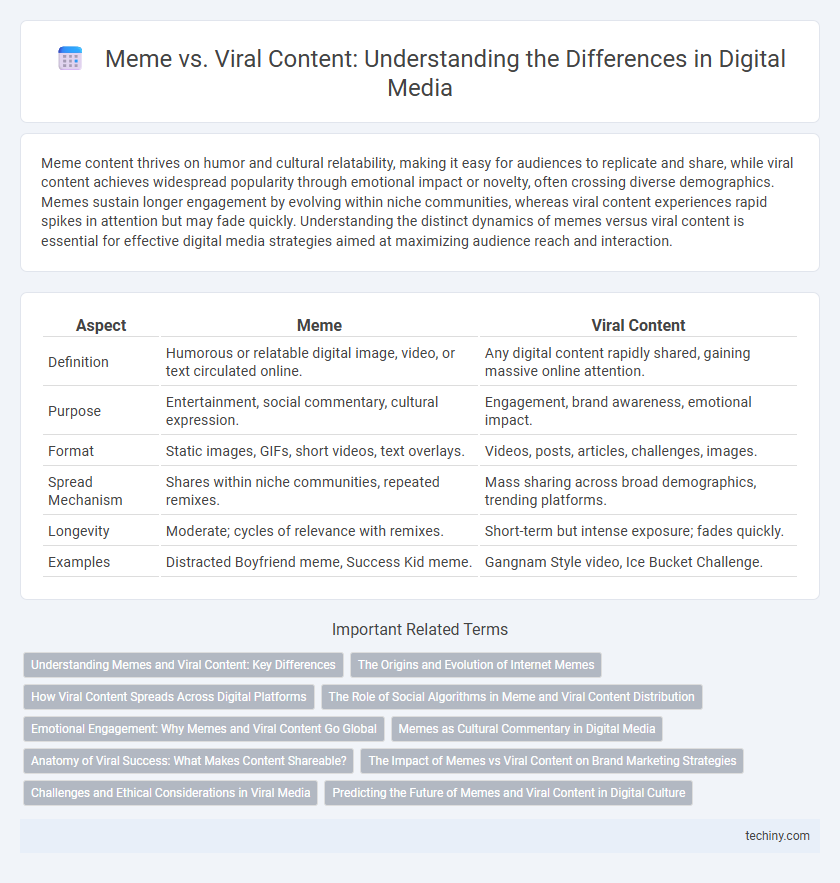Meme content thrives on humor and cultural relatability, making it easy for audiences to replicate and share, while viral content achieves widespread popularity through emotional impact or novelty, often crossing diverse demographics. Memes sustain longer engagement by evolving within niche communities, whereas viral content experiences rapid spikes in attention but may fade quickly. Understanding the distinct dynamics of memes versus viral content is essential for effective digital media strategies aimed at maximizing audience reach and interaction.
Table of Comparison
| Aspect | Meme | Viral Content |
|---|---|---|
| Definition | Humorous or relatable digital image, video, or text circulated online. | Any digital content rapidly shared, gaining massive online attention. |
| Purpose | Entertainment, social commentary, cultural expression. | Engagement, brand awareness, emotional impact. |
| Format | Static images, GIFs, short videos, text overlays. | Videos, posts, articles, challenges, images. |
| Spread Mechanism | Shares within niche communities, repeated remixes. | Mass sharing across broad demographics, trending platforms. |
| Longevity | Moderate; cycles of relevance with remixes. | Short-term but intense exposure; fades quickly. |
| Examples | Distracted Boyfriend meme, Success Kid meme. | Gangnam Style video, Ice Bucket Challenge. |
Understanding Memes and Viral Content: Key Differences
Memes are typically humorous, cultural symbols or ideas that spread rapidly within online communities through iterations and variations, reflecting shared experiences or emotions. Viral content, however, encompasses a broader range of media--including videos, articles, and images--that achieve massive reach and rapid distribution due to widespread engagement across platforms. Understanding the key differences involves recognizing that memes evolve through user-generated remixes, while viral content's success often depends on emotional impact and shareability across diverse audiences.
The Origins and Evolution of Internet Memes
Internet memes originated in the early 1990s as simple image macros shared on forums like Something Awful and 4chan, evolving rapidly with the rise of social media platforms such as Facebook, Twitter, and Instagram. These digital artifacts combine humor, culture, and social commentary, reshaping communication by turning shared experiences into relatable, replicable content. The evolution of memes has influenced viral content strategies by emphasizing participatory culture, where users actively remix and spread ideas, distinguishing memes from traditional viral videos or articles.
How Viral Content Spreads Across Digital Platforms
Viral content rapidly gains widespread exposure across digital platforms through user sharing, algorithmic boosts, and trending hashtags, creating exponential visibility. Platforms like TikTok, Instagram, and Twitter utilize AI-driven feeds to promote content with high engagement rates, accelerating spread beyond initial audiences. User-generated shares, influencer amplification, and cross-platform reposting synergize to magnify viral content reach, often resulting in global trends within hours.
The Role of Social Algorithms in Meme and Viral Content Distribution
Social algorithms prioritize content with high engagement rates, accelerating the spread of both memes and viral content by targeting active user communities. Memes often benefit from algorithmic boosts due to their shareability and relatability, while viral content gains traction through sudden spikes in user interactions across diverse platforms. Understanding these algorithmic mechanisms is crucial for optimizing content distribution strategies and maximizing audience reach in digital media.
Emotional Engagement: Why Memes and Viral Content Go Global
Memes and viral content thrive on emotional engagement by evoking humor, relatability, and surprise, which trigger widespread sharing across social media platforms. The rapid emotional resonance facilitates global diffusion, turning localized jokes or trends into universal cultural phenomena. This emotional connectivity accelerates algorithmic promotion, maximizing visibility and extending the lifespan of memes and viral content in digital ecosystems.
Memes as Cultural Commentary in Digital Media
Memes serve as a powerful form of cultural commentary in digital media, distilling complex social and political issues into easily shareable and relatable imagery or phrases. Unlike viral content that rapidly spreads based on novelty or entertainment value, memes often carry nuanced meanings and reflect ongoing societal conversations through humor, satire, and symbolism. This distinctive ability allows memes to influence public discourse and shape collective cultural identity in the digital age.
Anatomy of Viral Success: What Makes Content Shareable?
Viral content thrives on emotional resonance, relatability, and timeliness, often leveraging humor, surprise, or controversy to spark widespread sharing. Memes, as a subset of viral content, rely heavily on cultural references and adaptability, enabling users to remix and personalize the message rapidly across social platforms. The anatomy of viral success involves a perfect storm of platform algorithms, user engagement patterns, and network effects that amplify reach beyond initial audiences.
The Impact of Memes vs Viral Content on Brand Marketing Strategies
Memes drive brand engagement by leveraging humor and relatability, creating organic connections with target audiences that enhance brand personality and loyalty. Viral content, characterized by rapid and widespread sharing, boosts brand visibility and reach through mass exposure but often lacks the consistent emotional resonance that memes provide. Brands integrating memes into marketing strategies benefit from sustained audience interaction, while viral campaigns generate immediate spikes in awareness, influencing long-term customer retention differently.
Challenges and Ethical Considerations in Viral Media
Viral content often spreads rapidly, raising challenges related to misinformation, exploitation, and privacy breaches that can harm individuals or communities. Memes, while typically humorous and culturally relevant, may perpetuate stereotypes or offensive material, necessitating ethical scrutiny in their creation and sharing. Both formats require responsible content moderation and clear guidelines to balance freedom of expression with respect for ethical standards in digital media.
Predicting the Future of Memes and Viral Content in Digital Culture
Memes and viral content both shape digital culture, but memes rely on cultural references and creativity, while viral content spreads rapidly through mass appeal and shareability. Predicting the future of memes involves analyzing evolving social trends, platform algorithms, and user engagement patterns that influence meme adaptability and longevity. Viral content will increasingly depend on real-time data analytics and AI-driven personalization to capture audience attention and maximize reach across global digital networks.
Meme vs Viral Content Infographic

 techiny.com
techiny.com